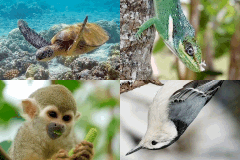AnAge entry for Notophthalmus viridescens
Classification (HAGRID: 00169)
- Taxonomy
-
Kingdom: Animalia
Phylum: Chordata
Class: Amphibia (Taxon entry)
Order: Caudata
Family: Salamandridae
Genus: Notophthalmus
- Species
- Notophthalmus viridescens
- Common name
- Eastern newt
- Synonyms
- Triturus viridescens, Diemictylus viridescens
Lifespan, ageing, and relevant traits
- Maximum longevity
- 25 years (captivity)
- Source
- website feedback
- Sample size
- Medium
- Data quality
- Acceptable
- Observations
As in other similar species, these newts feature extensive regeneration capabilities [0483]. They can live up to 15 years in the wild [0749]. One specimen kept as a pet was still alive when over 25 years of age (website feedback), which is a plausible anecdote. A female reportedly lived for 15 years in captivity [0528]. In some populations, sexual maturity can be reached in 1 year, but it usually takes at least 3 years. Some data suggests males may reach sexual maturity slightly sooner than females [0749].
Life history traits (averages)
- No information is available on life history. Please contact us if you wish to suggest or contribute data.
Metabolism
No information on metabolism is available.
References
- [0483] McGann et al. (2001), Mammalian myotube dedifferentiation induced by newt regeneration extract (PubMed)
- [0525] Smirina (1994), Age determination and longevity in amphibians (PubMed)
- [0233] Reilly (1986), Ontogeny of cranial ossification in the eastern newt, Notophthalmus viridescens (Caudata: Salamandridae), and its relationship to metamorphosis and neoteny (PubMed)
- [0528] Partners in Amphibian And Reptile Conservation: Northeast Working Group
- [0749] AmphibiaWeb
External Resources
- Integrated Taxonomic Information System
- ITIS 173615
- Animal Diversity Web
- ADW account
- Encyclopaedia of Life
- Search EOL
- NCBI Taxonomy
- Taxonomy ID 8316
- Entrez
- Search all databases
- Ageing Literature
- Search Google Scholar or Search PubMed
- Images
- Google Image search
- Internet
- Search Google

